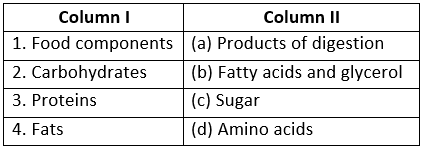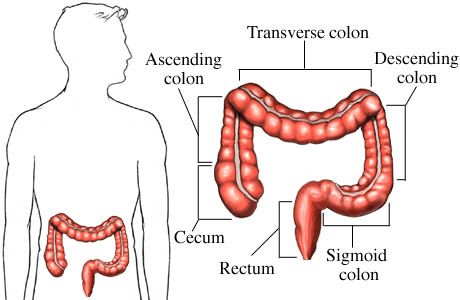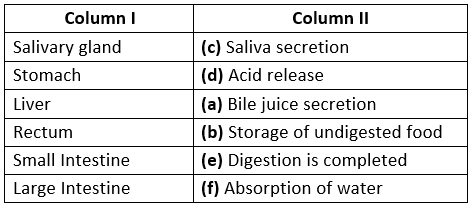Class 7 Science Chapter 2 Question Answers - Nutrition in Animals
Q 1. Fill in the blanks:
(i) The main steps of digestion in humans are _________ and ___________.
buccal cavity, oesophagus, stomach, small intestine and large intestine.
Buccal cavity
(ii) The largest gland in the human body is _________.
liver
(iii) The stomach releases hydrochloric acid and ______ juices which act on food.
digestive juices
(iv) The inner wall of the small intestine has many finger-like outgrowths called _________.
villi
(v) Amoeba digests its food in the ____________.
food vacuole
Q 2. Mark ‘T’ if the statement is true and ‘F’ if it is false:
(i) Digestion of starch starts in the stomach.
False
(ii) The tongue helps in mixing food with saliva.
True
(iii) The gallbladder temporarily stores bile.
True
(iv) The ruminants bring back swallowed grass into their mouth and chew it for some time.
True
Q 3. Choose the correct option:
(a) Fat is completely digested in the
(i) stomach
(ii) mouth
(iii) small intestine
(iv) large intestine
Correct Answer is Option (iii)
The majority of fat digestion happens once it reaches the small intestine. This is also where the majority of nutrients are absorbed. Your pancreas produces enzymes that break down fats, carbohydrates, and proteins. Your liver produces bile that helps you digest fats and certain vitamins.
(b) Water from the undigested food is absorbed in the
(i) stomach
(ii) food pipe
(iii) small intestine
(iv) large intestine
Correct Answer is Option (iv)
Large intestine is playing a key role in our digestive system; it can absorb most of the water from undigested food.
Q 4. Match the items in column I with those in column II:
Food components Product(s) of digestion Carbohydrates Sugar Proteins Amino acids
Fats Fatty acids and glycerol
Q 5. What are villi? What are their location and function?
- The inner wall of the small intestine has thousands of finger-like outgrowths called villi.
- These are found in the small intestine. The villi increase the surface area for the absorption of food.
Q 6. Where is the bile produced? Which component of the food does it digest?
Bile is produced in the liver and is stored in a sac called the gall bladder. Bile plays an important role in the digestion of fats.
Liver with Gall Bladder
Cellulose is a carbohydrate that can be digested by ruminants. Ruminants have a large sac-like structure between the small intestine and large intestine. The cellulose of the food is digested by the action of certain bacteria which are not present in human beings.
Q 8. Why do we get instant energy from glucose?
Because glucose easily breakdown in the cell with the help of oxygen and give carbon dioxide, water and energy.
Q 9. Which part of the digestive canal is involved in:
(i) Absorption of food __________.
Small intestine
(ii) Chewing of food __________.
Mouth
(iii) Killing of bacteria _________.
Stomach
(iv) Killing of bacteria _________.
Small intestine
(v) Formation of faeces ____________.
Large intestine
 Large Intestine
Large Intestine
Q 10. Write one similarity and one difference between the nutrition in amoeba and human beings.
- Similarity: During the digestion of food, in amoeba digestive juices are secreted into the food vacuole. They act on the food and break it into simpler substances. In a human being, the inner walls of the stomach and the small intestine also secrete the digestive juices. The digestive juices convert complex substances of food to simpler ones.
- Difference: Amoeba feeds on some microscopic organisms. When it senses food, it pushes out pseudopodia around the food particles. The food is trapped in a food vacuole. Human beings take food through the mouth, digest and utilize it. The food is gradually digested as food travels through the various compartments.
Q.11. Match the items of column I with suitable items of column II:
Small Intestine
Q 12. Can we survive only on raw, leafy vegetables/grass? Discuss.
- We know that including all animals, fungi, many bacteria, non-green plants, and human beings do not possess the ability to synthesize their own food. Therefore depend on autotrophs for their food supply either directly or indirectly.
- The green plants (leafy vegetables/grass) trap solar energy and manufacture their food in the form of glucose. So, leafy vegetables and grass can provide sufficient energy required for the survival of human beings.
|
26 videos|32 docs|9 tests
|
FAQs on Class 7 Science Chapter 2 Question Answers - Nutrition in Animals
| 1. What is the importance of nutrition in animals? |  |
| 2. How do animals obtain their nutrients? |  |
| 3. What are the different types of nutrients required by animals? |  |
| 4. How do herbivores and carnivores differ in their nutritional requirements? |  |
| 5. What are the consequences of a poor diet in animals? |  |























